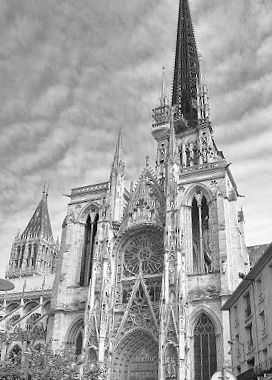France: Impressionist Normandy
Apple orchards, calvados, camembert, organic farmer’s market and the bucolic scenery came to mind as we head north from Paris to Normandy. But when I started firing my SLR camera, all the pictures turned out hazy and blurry like some ‘impressionist’ paintings. Blame it on my inability to work the new camera, but the photos made me realize that we’re in the region of France where life and art intermingles. Driving through Normandy is like seeing many impressionist paintings come to life. So what started as a weekend getaway in search of camembert and calvados turned into a few days of ‘Chasing Monet’.
Our first stop was at Giverny, an hour drive outside of Paris. It remains the quiet village where Claude Monet made his home and drew inspiration in his water lily paintings. The house, and the gardens outside and the water lily pond are now part of the Foundation Claude Monet (a museum of sort). Spring flowers like hyacinth, pompom daisies and small flowers with fragrance and colors typical of this time of year carpeted Monet’s garden. Although the water lilies were not in full bloom yet, the floating lily pods highlighted by the shifting light and by different shades of young greens from the trees and bushes surrounding the ponds, gave me a better perspective of the inspiration for Monet’s most famous painting.
Getting back on the road, we continued to the 17th-century port of Honfleur. It’s a charming village where you can lose yourself in the small and winding streets and end up at the famous landmark, Saint Catherine’s Church, the biggest wooden church in France. Built by local shipbuilders, the design is reminiscent of a sea vessel; it has two naves like upside-down hulls and pillars towering like masts. Honfleur has lots of fish markets and fresh produce markets. Restaurants lined the water’s edge, and the food (moules, camembert, and the poached pear) is worthy of another blog. Yes, the food was great that I could understand why still life paintings of apples, pears, fish were immortalized by many impressionist painters as much as the Normandy landscapes.
Rouen
 |
We drove an hour northwest to Rouen, most famous as the site where Joan of Arc was burned at the stake. We went right into the farmer's market, which was above the parking place near the Joan of Arc Memorial.
We walked to the Cathedral Notre-Dame of Rouen immortalized in Monet's painting. Seeing the front facade of the Gothic church with its lacy intricate design made me understand the inspiration for Monet to create a series of paintings of the gothic church.
After a visit to the church, we meandered around the cobbled street to see the massive 14th-century clock known as the Gros-Horloge and stopped for lunch. We visited the Musée des Beaux-Arts, to see impressionist masterpieces. Inside, we found classical paintings by the likes of Caravaggio, and impressionist interpretations of the architecture and scenes we saw outside – painted by Turner, Corot and of course Monet.
After a visit to the church, we meandered around the cobbled street to see the massive 14th-century clock known as the Gros-Horloge and stopped for lunch. We visited the Musée des Beaux-Arts, to see impressionist masterpieces. Inside, we found classical paintings by the likes of Caravaggio, and impressionist interpretations of the architecture and scenes we saw outside – painted by Turner, Corot and of course Monet.
Deauville and Bayeaux
It was a little foggy when we arrived in Deauville that we didn't get to see much of the town, but the hotels were affordable so we stayed there for the night. Deauville offers big hotels and casinos, probably for the visitors that flock into town for the American Film Festival in the late summer. The following morning we explored the coastal town that was immortalized by Eugene Bodin in the ‘Beach Scene' paintings. I thought it was cold and still early in the season to see the crowd scene depicted in Bodin's painting.
Although you would not find impressionist paintings in the museum at Bayeux, I highly recommend a visit there. The 200 plus feet tapestry, needlework that depicts the Conquest of England by William the Conqueror, was amazing.
Although you would not find impressionist paintings in the museum at Bayeux, I highly recommend a visit there. The 200 plus feet tapestry, needlework that depicts the Conquest of England by William the Conqueror, was amazing.
Honfleur
 |
| Edited my picture to create an impressionist effect |
Mont St. Michel
Our final destination was Mont St. Michel and we stayed a couple of days there. The first thing that a local guide would tell you about Mont St Michel is its history that dates back to the 8th century. The story has it that Archangel Michael appeared to the bishop of the nearby town of Avranches in a dream and asked him to build a church on top of a rocky island just out to the sea. And as they say, "the rest is history." We spent the whole day walking, climbing a number of steps to explore the whole place which is a medieval fortress, an abbey, a monastery and a village in itself. But for me, the beauty of Mont St. Michel is the whole mesmerizing landscape, a beautiful medieval fortress/monastery in the middle of the sea, that many of us have seen depicted by the Post-Impressionist painter - Paul Signac.
 |
| My edited picture of Mont St. Michel |
The trip to Normandy was a beautiful experience that left a lasting impression on me.
NOTE: Photos shot and edited by the author
NOTE: Photos shot and edited by the author



Comments
Post a Comment